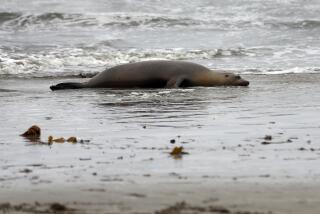Otter back at sea after rehab
Olive, the oil-slicked sea otter who gained a fan club on Facebook after washing up on a Monterey Bay beach in February, has returned to the sea.
She slid out of her cage into the waves at Sunset State Beach a week ago after six weeks of rehabilitation after being coated by a natural oil seep. Officials from the California Department of Fish and Game, who cared for the otter at their Marine Wildlife Veterinary Care and Research Center in Santa Cruz, had nicknamed her Olive.
And before being released, she was implanted with a tracking device so biologists from the Monterey Bay Aquarium can follow her and monitor her health.
“Olive . . . taught us a great deal about the pollution-related problems sea otters face,” said Fish & Game veterinarian Dave Jessup. “She is ready to return home.”
Sea otters are a protected species under state and federal law: Only about 2,800 southern sea otters are left in California. They help sustain kelp forests that are vital to ocean health by feeding on shellfish and other plant-eating species. And of course, they are cute, as nearly 900 fans on Olive’s Facebook page, set up by Fish & Game officials, can attest.
By midday Monday, aquarium officials reported, Olive was “acclimating well and currently resting.”
-- Margo Roosevelt
--
Don’t be a turkey
California’s spring turkey season is underway and the Department of Fish and Game is hoping hunters in this state will do their part to keep from shooting one another.
“California turkey hunters have a good safety record,” said Rob Allen, assistant chief of enforcement for Fish & Game. “First and foremost, identifying the target is essential. Hunters should always know what is behind their target before firing.”
Nationally, shooting-related turkey-hunting accidents average about 2.95 per year per 100,000 participants. That’s impressive, considering that the average was 8.1 in 1991.
-- Pete Thomas
--
Gray-water udpate
“It seems we needed to do this study three years ago,” said Sybil Sharvelle, principal investigator on a gray-water study that’s been in the works since 2006 and won’t be completed until mid-2011. “There’s a huge rush right now for information, and we’re just not at the point yet where we’re ready to provide results.”
Sharvelle is referring to “Long Term Effects of Landscape Irrigation Using Household Graywater,” a $450,000, two-phase study conducted by the Virginia-based Water Environment Research Foundation -- WERF, as the scientific research organization is known. It’s dedicated to wastewater and storm-water issues and is funded by hundreds of subscribers, including municipal wastewater agencies, environmental groups, chemical companies and cleaning products manufacturers.
They are all clamoring for more information on what has become a hot topic of late: recycling wastewater.
Gray water is the wastewater generated from washing machines, showers, baths and sinks (excluding kitchen sinks). About 50% of the wastewater generated in an average American household is gray water, which makes it an attractive option for water agencies looking not only to reduce consumer demand for potable water, especially in areas that are prone to drought, but the amount of wastewater those consumers are sending to the sewers for treatment.
California’s Department of Housing and Community Development is one of the many government agencies looking to the WERF gray-water study for guidance as it works to revise the state’s current gray-water standard. A preliminary version of the revised California gray-water code is expected in May. Interim results from WERF’s analysis of existing gray-water systems won’t be available until June.
What will those interim results entail? According to Sharvelle, it will be an analysis of the pathogens in soil samples that have been collected from four homes in three states (California, Colorado and Texas), all of which have been using gray water to irrigate their landscapes for more than five years. Most of those systems use gray water generated from washing machines; some also incorporate the gray water generated from baths, showers and bathroom sinks.
-- Susan Carpenter
--
Read more on The Times’ environmental blog: www.latimes.com/greenspace.
More to Read
Sign up for Essential California
The most important California stories and recommendations in your inbox every morning.
You may occasionally receive promotional content from the Los Angeles Times.









